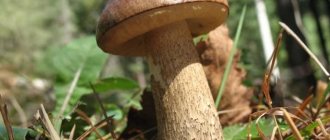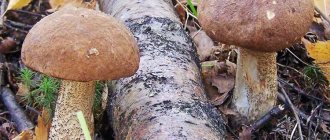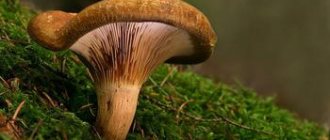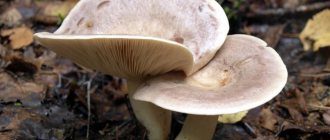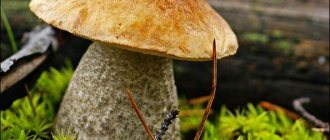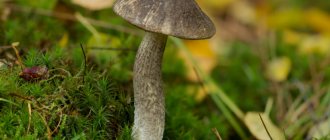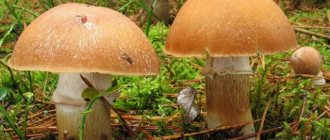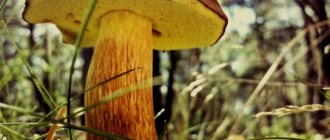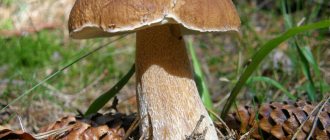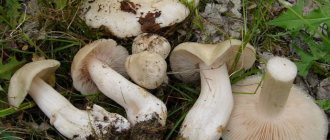Edibility
The caps of blushing umbrellas are mainly suitable for culinary use, since the flesh of the legs is noticeably tougher.
The collected mushrooms are freed from forest debris, scales are removed, washed, and then boiled and fried without any additional processing. They are suitable for drying and pickling. Connoisseurs and connoisseurs especially recommend preparing a shaggy umbrella by frying it in a sufficient amount of oil. Then its flesh acquires the most pronounced taste of chicken. During the mushroom season, the red umbrella is a fairly easy forest prey, because it grows in large groups, and not everyone knows the edibility of this mushroom.
It is only important to remember that in some regions this mushroom is listed in the Red Book
Boss moss
See also in other dictionaries:
- swamp moss
— n Food industry: Mohrrсhrling (mushroom) ... Universal Russian-German dictionary
Moss fly yellow-brown
- ? yellow-brown Scientific classification Kingdom: Fungi Division: Basidiomycetes ... Wikipedia
Moss fly yellow-brown
Yellow-brown moss
- ? Oiler yellow-brown Scientific classification Kingdom: Fungi Division: Basidiomycetes ... Wikipedia
Yellow-brown moss
- ? Oiler yellow-brown Scientific classification Kingdom: Fungi Division: Basidiomycetes ... Wikipedia
Characteristic features of the variety
Despite their geographical widespread distribution, ringed caps are undeservedly ignored
This happens due to the caution of mushroom pickers who confuse edible rosetes with its poisonous counterparts.
Chicken mushrooms really resemble the pale toadstool with its skirt, which is shown in the photo, but after studying the description and differences, you can easily recognize the edible forest delicacy.
Appearance and structure
Appearance changes as it grows. At the beginning of its development, the cap has the shape of a hemisphere with slightly curled edges, which are attached to the stem. The diameter of the cap is up to 4 cm. As it grows, the edges diverge and tear the cover, leaving a ring with a skirt on the leg to prevent tearing. The cap grows up to 10 cm in diameter and takes the shape of a wide cap with a bulge in the center.
The color of the cap is brownish-pink. In dry weather, the edges of the cap dry out and crack slightly. On the inside there are white-yellow plates of the spore apparatus, which acquire a rusty tint during the maturation of the spore powder. The outer side of the cap is dissected with thin creases, covered with a light coating. At the edge, the pollen forms scales that look like those of a fly agaric, which confuses inexperienced mushroom pickers.
The pale yellow leg is cylindrical in shape. The structure up to the ring is more silky and bright, above the ring it is scaly and pale. The pulp is dense with a pleasant mushroom smell. The color does not change when cut.
Place of distribution
The species is distributed in Europe, Asia, Japan, and the USA. In Belarus, chickens can be found everywhere. They grow throughout the area and are popular.
The favorite soil is damp and acidic, on which mixed and coniferous forests, as well as lingonberry and blueberry bushes, are well distributed. You can meet chickens both in the mountains and on the outskirts of swamps, which is why they received another name - marshlanders.
Taste and collection rules
An edible, tasty mushroom, the flesh of which resembles boiled chicken breast, and is consumed fried, stewed, pickled and salted. You should go hunting from July to October-November. If you come across a mycelium of chickens, then, without leaving your spot, you can collect a bucket, because they grow in vast plantations in a circle.
Since the marsh grass can be confused with its poisonous twins, when going for this species for the first time, you should take with you someone who understands them, or a picture of the edible and dangerous species. It is also necessary to use the main rule of mushroom pickers: if you’re not sure, don’t take it.
You should not take old, wormy or rotten mushrooms. If these have already ended up in your basket, then you shouldn’t throw them away or trample them, just prick the fruiting body onto a branch, and then, when ripe, it will shed spores and increase the yield.
How to distinguish from false, inedible
The ringed cap has two terrible doubles with which an inexperienced mushroom picker can confuse it - the fly agaric and the toadstool. You can distinguish it from a fly agaric by the following characteristics:
- the scales on the fly agaric cap extend over the entire area, but on the cap only along the edge;
- The smell of the pulp of an inedible mushroom is unpleasant, while that of an edible one is mushroom-like;
- the plates of the fly agaric are free, those of the cap are adherent to the stem;
- the fly agaric has a vulva at the base, the chicken does not.
When comparing with a pale grebe, pay attention to the following signs:
- Edible mushrooms do not have a sac-like formation at the base of the stem;
- The toadstool has fused plates, but the cap does not.
Pale toadstool often grows among caps, therefore, having discovered a rich clearing, it is necessary to inspect each fruiting body that is placed in the basket.
Boss moss
Growing
in a swamp in places difficult to reach for mushroom pickers. The mushroom is good in its own way, with a pleasant taste, without much odor.
hat
fleshy, convex, velvety, first ocher-yellow, then olive-brown, slimy in wet weather.
Pulp
thick, dense, yellowish, turns blue at the break.
Tubular layer
dirty yellow.
Controversy
brown with an ocher or olive tint.
Leg
cylindrical, dense, short, red-brown or pale yellow.
Beneficial features
Chicken coop, like many other mushroom species, has beneficial properties. Fruiting bodies are rich in protein, vitamins, polysaccharides, but have low calorie content.
The reddening umbrella has the following effects on the body:
- strengthens the walls of blood vessels, improves heart function;
- stimulates muscle growth;
- increases the body's resistance to bacteria, viruses, i.e. stimulates the immune system;
- stimulates brain activity;
- lowers blood sugar levels;
- helps remove toxins from the liver.
Also, components of this type have an anti-inflammatory effect. Consumption of the product slows down the aging process of cells due to antioxidant activity.
Medicinal properties and medicine
Among the people, healers called the cap “chicken mushroom”. Not so much because of the appearance, but because of the taste properties that appear after cooking. Indeed, the mushroom was used to make medicinal decoctions.
However, in today's modern Russia, the healing properties of the ringed cap are little known. However, among our neighbors, in Belarus, this mushroom is very common. It is used as a medicinal component for a number of serious diseases.
Very often it is used as a compress for enlarged lymph nodes and other tonsillitis diseases.
In the Baltics, this mushroom is also widely used for its medicinal properties. For example, they make a decoction of mushrooms. To do this, the ringed cap is collected in an amount of 500 g and placed in a three-liter pan. Boil for several hours, then strain thoroughly. This decoction is used to treat the kidneys and also help remove stones from the body.
In Poland, it is believed that the brine that remains after these mushrooms is an ideal hangover reliever, even better than medications. This solution is also used to rub swollen limbs and make compresses.
However, if we think more intelligently and turn to scientific medicine, then, unfortunately, we will not find any mention of the fact that the mushroom has truly healing properties. Moreover, Rosites is not included as a healing component in any composition of medications, which also speaks volumes about its importance for medicine.
Nutritional value and taste of goat kids
Goats are very often wormy. Only freshly picked mushrooms do not have a pronounced aroma. Goat's rue belongs to the fourth category of nutritional value.
The chemical composition of goat contains phosphorus, amino acids, phosphatides and lecithin. Vitamins B1, B2, PP were also found in goat. Mushrooms are dried and added to dishes as a dry powder.
. The taste is unobtrusive, quite soft, the smell is fruity.
The taste of goats is very similar to boletus, but true connoisseurs can tell the difference between them. It has been established that some species from the Oilcan family contain resinous substances that treat headaches.
Important!
Scientists have noted that mushrooms from the Buttercup family also absorb radioactive substances very well near industrial enterprises. It is not recommended to collect goats in such places.
Fiber also contains the element chitin, which is difficult for the body to absorb. People who suffer from intestinal and stomach problems are not recommended to eat goat meat. Some people believe that goat mushroom has a medicinal effect
, it contains an antimicrobial substance - nebularin.
Where and when to collect chicken mushrooms
These mushrooms grow throughout the European and Asian continents and are collected in the United States and Canada, as well as in Japan. Moreover, they can be found even in such harsh climatic conditions as Lapland, or in the dwarf birch forest of the Russian tundra. They are also found in mountainous areas among spruce or pine trees. Moreover, the best soil for marshlands is acidic. This type of soil can be identified by the plants growing on it - if blueberries or lingonberries grow in the area, then you can also find chickens there.
In the center and middle of our country, these mushrooms are usually found along the edge of swampy areas, where there is high soil moisture and moss is actively growing. That’s why in such areas they are called marshlands and marshlands. It is also found in large quantities in Belarus, where there are a lot of swamps.
Unfortunately, in a number of regions these mushrooms are considered inedible and are not collected, although, according to knowledgeable mushroom pickers, the taste of bog mushrooms is beyond praise.
Photos and pictures with the marsh mothweed (flaccid milkweed)
Bolethin swamp is a conditionally edible mushroom, which is among the ten most ancient mushrooms on our planet. It grows in deciduous or mixed forests, in areas with low and high humidity. Boletin is collected from the beginning of July to the end of September. The fungus is most often found in the Far East, Eastern and Western Siberia, as well as in the deciduous forests of Asia and North America. In European and central Russia, boletin is distributed in cultural landscapes.
Bolethin boletus belongs to the Boletaceae family, genus. The mushroom is also found under the names marsh lattice, fireweed, and false butterfly. The popular names are the following: moss mushroom, mullein, cow mushroom, kid, bog mushroom, sheep.
Description and characteristics of the mushroom
The chicken mushroom belongs to the genus Cortinarius, family Cortinariaceae. Latin name: Cortinarius caperatus, Rozites caperatus, Cortinarius caperatus. In common parlance, this species is also called: Turk mushroom, goose mushroom, jaundice mushroom, Pribolothukh mushroom, cap mushrooms. Scientific names: Annular cap, White marshweed, Rosites dull.
The cap of a cockerel varies from 5 to 12 cm in diameter. In young fruiting bodies it is hemispherical and resembles a chicken egg with drooping and turned-down edges. But with age it becomes flat-convex, the edges rise, and a small hump appears on top. During periods of drought, the edges of the cap crack. The skin of the chicken is wrinkled and fibrous, and has a small coating in the form of a white coating. The color of the cap can vary from silvery-white to yellowish-pinkish-brown.
The hymenophore (lower part of the cap) is plate-type. The plates are white or yellowish in young specimens, and after the cap opens, in adulthood, they become yellow. The ocher-rusty hue of the plates of the edible mushroom distinguishes it from its poisonous companions, whose plates remain invariably white.
When cut, the pulp has a dense consistency, fibrous and watery. When cut, the color does not change; it is yellowish or whitish. The smell is pleasant, mushroom. It is worth noting that chickens are often affected by worms.
The leg has a cylindrical shape, its base is slightly thickened, which resembles the characteristic features of the fly agaric. There is a membrane that, when broken, forms a ring that fits tightly around the leg. The surface is silky at the base; scales can be seen in the upper part. The color of the leg is pale yellow, the lower part is more intense.
A little history
The cockerel and hen mushroom was first described and given the binomial name Rozites caperatus in 1879 by the Finnish mycologist-taxonomist Peter Adolf Karsten.
External signs
hat
from five to ten centimeters, cushion-shaped, with a tubercle in the middle. The surface is dry, felt-scaly. Young mushrooms are usually brightly colored: the color varies from burgundy and cherry to bright red. With age, the color becomes less saturated, the caps are painted in an ocher shade with admixtures of yellowness. Closer to the edges of the cap, remnants of the veil are often visible. The color of the tubular layer of the mushroom can vary from yellow to yellow-ochre, covering part of the stem. In young specimens, the tubular layer is covered with a light pink blanket having a film structure. The pores are quite wide (up to half a centimeter).
Leg
from four to seven centimeters in height, reaching one to two centimeters in diameter. The color of the leg is yellowish at the top, turning red towards the bottom. As a rule, the color of the stem is several tones lighter than the cap. The stem is filled, thickened towards the bottom, and often has traces of a ring.
Pulp
It has a bitter taste and a not too pronounced odor, which is rather unpleasant in old mushrooms. The color of the pulp is yellow, sometimes with a blue tint on the cut.
Spore powder
pale brown color.
Externally, it is similar to the Asian boletin, which can be distinguished by its more elegant structure and hollow stem. However, the Asian counterpart is edible, so it’s not so scary to confuse them.
How to cook delicious chicken
The ringed cap is classified by many mushroom pickers as a gourmet mushroom, whose taste qualities are not inferior to the famous and most “noble” varieties. Such mushrooms can be harvested for future use or used to prepare first and second courses. It must be remembered that mushroom preparations must be stored in a cool basement or refrigerator at a constant temperature of 0-6°C.
Pickling
Peel the fruiting bodies, separate the caps and cut into two or four pieces. Prepare a marinade from a liter of water, half a glass of 9% table vinegar, three cloves, one bay leaf, eight black pepper, 70 g granulated sugar and 30 g salt. Place the mushrooms in boiling water and boil for a quarter of an hour, then quickly cool in running water. Cold mushrooms are dipped into a boiling marinade, and after a couple of minutes they are placed in hot and sterilized glass jars, which are rolled up with lids.
Pickling
Rinse thoroughly in running water and boil the mushroom caps for a quarter of an hour, then quickly cool under running water and salt in layers using coarse rock salt. The standard salt consumption is approximately 350-370 g per bucket. It is allowed to top the pickled mushrooms with black currant and horseradish leaves. Oppression is installed on top. With this method of salting, the chickens are ready for consumption in about a month and a half. It is best to store fully prepared salted mushrooms in the basement or in a regular household refrigerator.
Clear and aromatic mushroom soup
After washing in running water, small mushroom caps are cut in half or into four parts, and larger ones are cut into fairly small pieces. Then you need to cut the onions, parsley root and carrots into slices, then boil them in water until half cooked.
Rules for eating
The structure of the chicken pulp resembles chicken breast fibers. Despite the fact that, in terms of its taste, the mushroom belongs to the fourth category, connoisseurs of caps celebrate them as a delicacy dish.
Useful properties and restrictions on use
Caps, like many edible mushrooms, have medicinal properties in moderate doses, but also a number of contraindications. Useful properties include:
- lowering cholesterol and sugar levels;
- prevention of arrhythmia;
- prevention of infectious diseases and oncology;
- normalization of blood pressure;
- Mushroom pickle is a folk recipe for a hangover.
Among the contraindications are the following:
chronic pancreatitis; dysbacteriosis; age up to 6 years (do not use at all), from 6 to 14 very carefully due to the immature enzymatic system; mono-diets using mushrooms; allergic reactions, both to mushrooms and during the period of activity of any other allergy; chronic diseases (reduce to once every two weeks).
Treatment
Since chicken mushrooms are edible mushrooms, it is not necessary to boil them if you are planning a different cooking method. It is enough to clean well of forest debris, cut off the remains of the mycelium, cut out wormy places, rinse thoroughly under running water and dry a little. The stems of old marsh plants are not used, as they harden, and the spore apparatus on the inside of the cap is cut off, since the spores are not digested.
Cooking features
As already mentioned, it is not necessary to boil the caps, but if the collection site was close to the city or contaminated areas, you should boil the mushroom in order to remove all the accumulated dirt from it, which it absorbs like a sponge.
For this, it is important not how long to cook, but how often to change the water. The best way is to boil it three times for five minutes after boiling, then drain the water.
If boiling is part of the recipe, then they will be ready 10-15 minutes after boiling.
Marinating and salting
You can salt the swamps using hot or cold methods. Ideally salted in an oak barrel. To prepare a barrel for cold salting, you need to wash it well and steam juniper branches in it, which will disinfect the barrel for further manipulation.
Peeled and washed mushrooms are placed in layers in a barrel. For one serving you will need 5 kg of product. Each layer is well salted. This amount will require 350 g of salt. The contents of the barrel are filled with cold water and covered with a wooden lid of smaller diameter under pressure. It’s hard to take one that can be calcined and steamed with juniper. Within 7 days, the foam that forms in the barrel is removed.
At the end of the week, the water is drained, the barrel is rinsed with clean water and dill with seed umbrellas is placed at the bottom. The mixture is being prepared for re-salting. For 5 kg of the main ingredient, take 150 g of salt, 10 g of cloves and 15 g of allspice. Everything is mixed and salted in each layer. It is again filled with clean cold water and sent under oppression for 1.5 months in a dark, cool room.
A faster option for hot salting. To do this, you will first need to boil the peeled mushrooms for 5 minutes 2 times, changing the water. For the brine, take 2 liters of water, add 75 g of salt, 3 allspice peas, 2 pcs. cloves, 5 black peppercorns. Let the brine boil for a couple of minutes and add the mushrooms squeezed out of the water and cook for 5 minutes.
Prepare liter jars by sterilizing them first. Place a bay leaf, 3-4 cloves of garlic, and 2-3 onion rings into each jar. Pour boiling brine into the jars along with the mushrooms and roll up with iron lids. After cooling, store in the refrigerator or cellar.
To marinate the caps, you must also first boil them once and drain the water. Further methods of marinating are very variable and vary depending on the recipe. But the classic marinade recipe is similar for all mushrooms. Rosites are poured with cold water and brought to a boil. Add cloves, black pepper, allspice, and bay leaves to the water to taste. The mushrooms are boiled in the marinade for about an hour, then sealed in sterilized jars.
About the existence of false kids
Sometimes grates are confused with moss mushrooms or boletus mushrooms.
In general, false goat's rue does not exist in nature. The kid's inedible counterpart is the pepper mushroom. Its flesh has a peppery taste and is neither edible nor poisonous. Dried goat is used as a seasoning for dishes. There are known cases when pepper mushrooms were served as a spicy snack with vodka. If you cook it for a long time, it will lose the pepper flavor. Cooked together with other mushrooms, peppercorns will not spoil the dish.
Reshetniks are distinguished from boletus by their skirt; the color of the boletus can be yellow, dark or light brown. Young goats have a very neat hat that looks like a pillow. On old slingshots it changes shape and cracks. You can distinguish the mushroom from boletus and moss mushrooms by the change in shape as the cap grows.
These delicious chicken mushrooms
Not everyone knows how to prepare a ringed cap. However, those who are already familiar with their taste believe that when fried they are simply delicious. To prepare such a culinary masterpiece, the chickens need to be cleaned and washed thoroughly. Some housewives like to boil them first and then fry them, others prefer to brown them fresh in oil. How to eat these mushrooms is a matter of taste, but they are especially good in a batter made from flour, eggs, mayonnaise and spices. First, the chickens need to be dipped in it, then rolled in breadcrumbs and placed in a hot frying pan, in which the sunflower oil is already sizzling. Frying time is approximately five or seven minutes.
Anything prepared this way is eaten instantly. The taste of chicken mushrooms, the photo of which somewhat resembles fly agarics, is similar to tender chicken meat.
Description of the ringed cap
The mushroom body of the annular cap consists of a stalk with a length of 4 to 12 centimeters and a cap, the diameter of which ranges from 5 to 15 centimeters. The cap has the shape of a hemisphere or cap, with the edges turning inward, hence the name of the mushroom.
As the cap ripens, the cap changes its shape to a flat one, while the top rises.
The surface of the cap is wrinkled with a fibrous coating of a light shade. In dry weather, cracks form along the edges of the cap. The color of the cap is yellowish, and the shade can be straw or gray. The edges of the cap are decorated with stripes.
The pulp is loose, tender, white, and turns yellow over time. The pulp has a pleasant aroma and taste. The plates are of different lengths, they are located rarely. At different ages of the mushroom, the color of the plates varies from yellow to brown.
The leg of the cap is ring-shaped and cylindrical, its base is thickened. The surface of the stem is silky-fibrous. A little above the central part of the leg there is a film ring. The ring sits tightly on the body of the leg, its color changes with age from white to yellow.
The upper part of the leg is yellowish, shrouded in flakes and scales. The leg, below the ring, is light ocher in color; at the base of the leg there are elements of the bedspread, their color is pale violet. The spores are warty, almond-shaped, ocher. Ocher-colored spore powder.
Places of growth
The annular cap grows in mixed and pine forests, giving preference to blueberries, and is less common in oak forests. In the north of their range, these mushrooms can be found under dwarf birch trees. That is, they form mycorrhizae with coniferous trees, birches and oaks.
The annular cap grows in the middle zone, preferring acidic and moist soils. Quite often these mushrooms can be found in pine forests with a lot of moss. They can also grow in the mountains.
The season for collecting caps lasts from July to October. These mushrooms grow in small groups. In our country, ringed caps grow in the Central and Western parts. In addition, they are common in Belarus and Europe.
Edibility of the annular cap
This is not an easily edible mushroom; it is considered a delicacy. Only the caps are used for cooking. They can be used as food through heat treatment. Ringed caps can be boiled, stewed and pickled.
Young mushrooms have better taste, but when the annular caps mature, the stem becomes too hard and must be removed during processing. In Western European countries, these mushrooms are considered a delicacy.
Similar species
The ringed cap is similar to several types of poisonous mushrooms. This mushroom can be distinguished from fly agarics due to the presence of a powdery coating on the cap, the absence of a volva, whitish scales and the ocher color of the spore powder. In addition, in an adult annular cap the plates are painted rusty-brown, while in fly agarics they are white.
Also, the ringed cap looks similar to the purple spider web and certain types of brown spider webs, most of which are poisonous. The ringed cap differs from the webworts by its stalk: the spiderwebs have only fibrous remains of the cover on their legs.
The ringed cap (Rozites careratus) is an edible variety belonging to the family Cobwebs and the genus Cortinarius. In Western European countries, such a mushroom is considered a delicacy.
The annular cap is an edible variety belonging to the family Arachnidaceae and the genus Arachnididae
The cap is quite fleshy, hemispherical or cap-shaped, sometimes flat-convex in shape, with rolled edges. The surface is gray-yellow, straw-yellow or ocher, with stripes on the edges, wrinkled and covered in the central part with a pale pearly fibrous coating. On too dry and hot days, the edges of the cap can crack very characteristically.
The pulp is loose and soft, white or yellowing in color, with a very pleasant aroma and quite delicate taste.
False doubles
White birch is difficult to confuse with other mushrooms; its growing place is special, and its appearance is quite recognizable. It is similar to some of its fellows, belongs to the group of lower taste quality, and has no poisonous counterparts.
| Name | Hat and hymenophore | Leg | Danger |
| Swampman | Light, yellowish, whitish then brown plates | White, grayish, thin | Edible |
| Common bobwhite | Color from white to dark gray | White thickened, there are dark scales | Edible |
| Bile mushroom | Yellow-brown, brownish, velvety, white plates, then turn pink | Club-shaped or cylindrical, yellow, ocher | Inedible, very bitter, often classified as dangerous |
If you collect gall mushroom instead of boletus, you will hardly be able to eat it, it is too bitter, and cooking only intensifies this property. In addition, it turns red on the break and looks much darker.
Chicken marinated mushrooms recipe for the winter
Housewives often make vegetable and fruit preparations for the winter. But mushrooms do not go unnoticed. They can be salted, frozen and pickled. The marinating recipes are especially interesting.
Using this method, mushrooms are not only preserved for at least six months, but can also be used later to prepare various dishes - from first dishes to appetizers.
They are also good as an independent snack for the holiday table.
One of the varieties that can be marinated is chicken. Recipe for marinated chicken mushrooms Many mushroom pickers do not really value them, but this is not justified: they are edible, grow in large groups, and taste as good as champignons.
Also on our website you can find recipes on how to pickle boletus mushrooms so that your whole family will like them.
A little about “chickens”...
Chickens, also known as Ringed Caps, are an edible variety of mushroom that grows in places with high humidity from August to October. It is a mushroom with dense flesh, a bell-shaped cap of a light yellow or pinkish hue.
Quite popular for pickling and salting. Chickens are also known as Turks, white marshworts, and dull rosites. The taste is similar to champignons; young mushrooms are especially tasty.
In some European countries it is considered a delicious mushroom.
Marinated chicken for the winter
Note! It is believed that the most delicious part of a chicken is the cap - tender and aromatic flesh. In addition, there is a risk of finding insects in the legs. Chickens, like any other mushrooms, are not recommended to be mixed with other varieties when pickling
But when preparing soup or salad, you can use different mushrooms. Why can’t you marinate several types together? This is because some varieties of mushrooms have their own cooking nuances. And if you cook them together, the seaming can go bad very quickly.
Let's look at several options for preparing white botanicals.
Ingredients for cooking:
- chickens - 1 kg;
- water - 0.7 l;
- vinegar 9% - 2/3 of a regular glass;
- table salt - 1 tbsp. l.;
- sugar - 1 tsp;
- laurel - 1-2 leaves;
- citric acid - 5 g.
- Pour water into a saucepan. It is recommended to use a container with an enamel coating; aluminum cannot be used.
- Add salt, sugar and vinegar.
- As soon as the marinade boils, reduce the heat. Add pre-prepared chicken, bay leaves and cook for 15 minutes. During cooking, foam will appear on the surface. It must be collected with a slotted spoon and thrown away, otherwise the marinade will be cloudy.
- After 15 minutes of cooking the mushrooms, add acid and turn off the heat.
- Leave the mushrooms in the marinade to cool.
- Sterilize the jars.
- Place the mushrooms in jars and pour in the marinade. Roll up tightly.
The caps prepared using this method acquire a pleasant smell of spices.
Ingredients:
- ordinary water - 1.5 liters;
- marsh mushrooms - 1 kg;
- salt - 2 1/4 tbsp. spoons;
- pepper - 6 peas;
- cloves - 1 bud;
- bay leaf - 1 piece;
- citric acid - gram;
- vinegar 9% - 1/3 cup.
- Cooking begins with boiling the mushrooms.
- Pour water into a saucepan and heat.
- As soon as the water boils, add 2 tablespoons of salt and stir well.
- Peel and wash the mushrooms.
- Place the chickens in a container; when the water boils again, reduce the heat.
- Cook for 20 minutes, then pour out the liquid and leave the mushrooms to drain in a colander.
- Sterilize jars and lids.
- When the liquid has drained, place it in a container.
- While the mushrooms are draining, prepare the marinade.
- Pour 0.5 liters of water into an enamel container and place it on the stove over high heat to boil faster.
- Add 1/4 tablespoon of salt, all the spices and acid to the water.
- Boil the entire composition for 25 minutes. Then turn off the stove.
- Pour vinegar into the marinade. Leave to infuse for 15 minutes.
- Pour the marinade into jars with pre-packed mushrooms.
- Seal tightly and cover with a towel. When it cools down, place it in an unlit place with a temperature of 6 to 10 degrees.
For thrifty housewives, we have also prepared recipes for pickled squash, which will not only decorate your dining table, but will also be a wonderful and tasty addition to your dinner.
The chickens turn out sweet and spicy, while maintaining their own flavor.
Mushroom value
Cockerels are a desirable product in cooking. They are edible, and you can cook them as your heart desires. The calorie content of the mushroom is 22 kcal per 100 g. Nutritional value of 100 g of the ringed cap:
- protein – 3.09 g;
- carbohydrates – 3.26 g;
- fats – 0.34 g.
The ringed cap also contains:
- water – 92.45 g;
- fiber – 1 g;
- sugar – 1.98 g.
Mushrooms are rich in vitamins C and D, thiamine, riboflavin, minerals - calcium, magnesium, selenium, zinc, phosphorus, iron, potassium, sodium and other useful elements.
Chickens are a valuable product; they taste like champignons. In Russia, this mushroom is undervalued, but in Europe it is considered a delicacy and is even grown artificially.
It’s not for nothing that this mushroom is called such delicate food names – hens and cockerels. The ringed cap is not only edible, but also versatile - it can be prepared in any way. Chickens are classified in the 4th food category, which indicates their low nutritional value.
All restrictions on the consumption of cockerels are associated with a characteristic feature of mushrooms - they accumulate heavy metals present in the environment in their bodies. Therefore, they cannot be collected near roads and in environmentally unfavorable areas.
Harm and benefit
Caps, like other mushrooms, have medicinal properties. But they can also cause harm.
Beneficial features
- Regular consumption of this mushroom reduces blood sugar and cholesterol levels, normalizes blood pressure, fights arrhythmia, and reduces possible risks of cancer and infectious diseases.
- The product is a good antioxidant and has antiviral and anti-inflammatory effects.
- In some countries, the mushroom is used to remove kidney stones.
- Mushroom pickle is considered an excellent hangover cure.
How to cook?
The cap can be boiled, fried, salted and pickled. The gastronomic qualities are very similar to the well-known champignons. The caps are more often eaten; they have a milder taste and are less likely to contain insect larvae. Mushrooms are used to prepare soups, main courses of meat, vegetables, and poultry.
Prolonged heat treatment affects the taste of the product, for this reason it is added at the final stage of preparation. The cap does not have as pronounced a taste and aroma as other mushrooms; it is better to mix it with other varieties.
